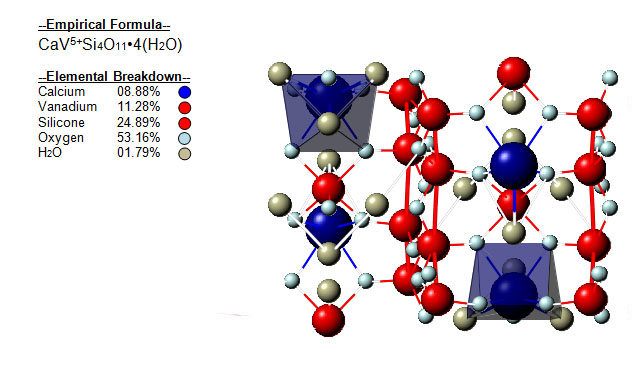![]()
The mineral cavansite derives its name from its chemical composition as a calcium vanadium silicate. Cavansite is a deep blue hydrous calcium vanadium phyllosilicate mineral, occurring as a secondary mineral in basaltic and andesitic rocks along with a variety of zeolite minerals. Discovered in 1967 in Malheur County, Oregon, cavansite is a relatively rare mineral. It is polymorphic with the even rarer mineral, pentagonite. It is most frequently found in Poona, India and in the Deccan Traps, a large igneous province.
![]()
Within the metaphysical rehlm of minerals, Cavansite aids in many psychic areas. It can stimulate the believer's intuition greatly, heightens psychic awareness, stimulates their Third Eye, strengthens all of the Clairs and enhances channeling abilities. It is especially helpful in psychic healing and protects the believer during psychic healing sessions. Emotionally, Cavansite helps get rid of negative thoughts and beliefs, and inspires new ideas. It helps the believer to see what part of life needs their attention and can draw in information from other dimensions and realities that their soul is partaking in simultaneously, including past and future.
Please note that MIROFOSS does not suggest in any way that minerals should be used in place of proper medical and psychological care. This information is provided here as a reference only.
![]() While cavansite does contain vanadium, and could be a possible ore source for the element, its rich colour and relative rarity, make cavansite a sought after collector's mineral.
While cavansite does contain vanadium, and could be a possible ore source for the element, its rich colour and relative rarity, make cavansite a sought after collector's mineral.
![]()
Cavansite is a secondary mineral in basalts and andesites.
![]()
Cavansite is a distinctive mineral. It tends to form crystal aggregates, generally in the form of balls, up to a couple centimeters in size. Sometimes the balls are coarse enough to allow the individual crystals to be seen. Rarely, cavansite forms bow tie shaped aggregates. The colour of cavansite is distinctive, almost always a rich, bright blue. Also the other minerals that are associated with cavansite are useful for identification, as cavansite is frequently found sitting atop a matrix of zeolites or apophyllites.
![]()
| Cleavage | Good | |
| Colour(s) | Greenish blue, Dark blue | |
| Specific Gravity | 2.25 | |
| Diaphaneity | Subtranslucent | |
| Fracture | Brittle | |
| Mohs Hardness | 3.0 to 4.0 | |
| Luminescence | Non-fluorescent | |
| Luster | Vitreous | |
| Streak | Bluish White | |
| Habit(s) | Prismatic | |
| Radioactivity | Non-radioactive | |
| Magnetism | Non-magnetic |
![]()
No known health risks have been associated with cavansite. However ingestion of cavansite, as with other naturally occurring minerals, is not recommended.
![]()
The following image shows the Elemental breakdown of the mineral cavansite along with the mineral crystal structure.

![]()
| Crystal System | Orthorhombic |  |
| Class | Dipyramidal | |
| Axial Ratios | a : b : c = 0.7148 : 1 : 0.7019 | |
| Twinning | Spherulitic rosettes | |
| Optical Data Type | Biaxial (+) | |
| Pleochroism (x) | Colourless | |
| Pleochroism (y) | Blue | |
| Pleochroism (z) | Colourless |  |
| RL Values | nα = 1.542(2) nβ = 1.544(2) nγ = 1.551(2) | |
| 2V | Measured: 52° , Calculated: 58° | |
| Max Birefringence | δ = 0.009 (See colour chart at right) | |
| Surface Relief | Low | |
| Dispersion | r < v extreme |
![]()
The mineral cavansite can be translated into the following select languages:
| Arabic | Bulgarian | Chinese (Sim) | |||
| Croatian | Czech | Danish | |||
| Dutch | Cavansiet | Esperanto | Estonian | ||
| Finnish | French | German | Cavansit | ||
| Greek | Hebrew | Hungarian | |||
| Italian | Japanese | カビンチャイト | Korean | 카빈차잍으 | |
| Latin | Lithuanian | Norwegian | |||
| Persian | Polish | Cavansyt | Portuguese | ||
| Romanian | Russian | Кавансит | Slovak | ||
| Spanish | Cavansita | Swedish | Tagalog | ||
| Turkish | Ukrainian | Vietnamese |
![]()
Cavansite can be found in only a few places around the world. The map below shows major documented concentrations of cavansite:

![]()
 |
The MIROFOSS database offers free printable geological identification tags for personal and non-profit use. These tags can be used to properly identify mineral samples in your collection. -Click here- to download a full size jpeg image for a cavansite identification tag; which can be printed on paper or used with a plastic laser printer. |
 |
What's this? What can I do with it? |
![]()
| Chemical Composition | shida, N., Kimata, M., Nishida, N., Hatta, T., Shimizu, M., Akasaka, T. (2009): Polymorphic relation between cavansite and pentagonite: Genetic implications of oxonium ion in cavansite. Journal of Mineralogical and Petrological Sciences, 104, 241-252 |
| Crystallography | Evans, H.T., Jr. (1973): The crystal structures of cavansite and pentagonite. Amer. Mineral., 58, 412-424. |
| History | Staples, L.W., H.T. Evans, Jr., and J.R. Lindsay (1973): Cavansite and pentagonite, new dimorphous calcium vanadium silicate minerals from Oregon. Amer. Mineral., 58, 405-411. |
| Geograpcial Data | Mindat.org. Retrieved on 2012-07-15 |
| Physical Identification | Webmineral.com. Retrieved on 2012-07-15. |
| June 25, 2014 | The last time this page was updated |
| ©2017 MIROFOSS™ Foundation | |
 |
|






